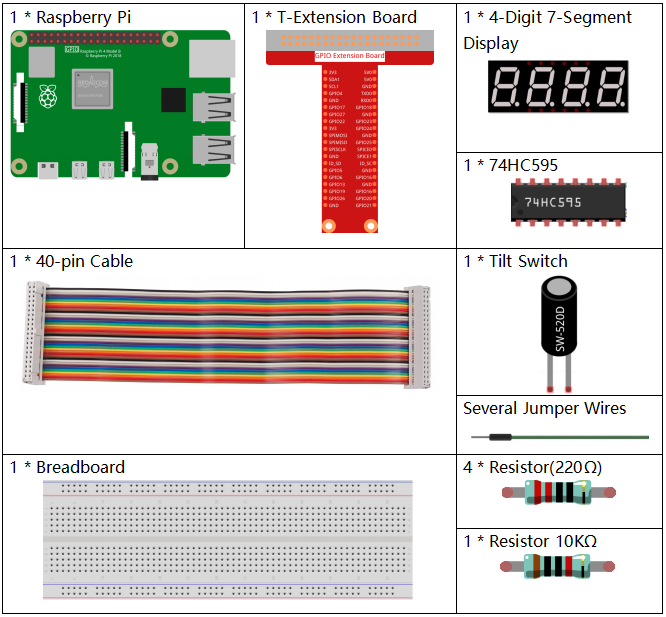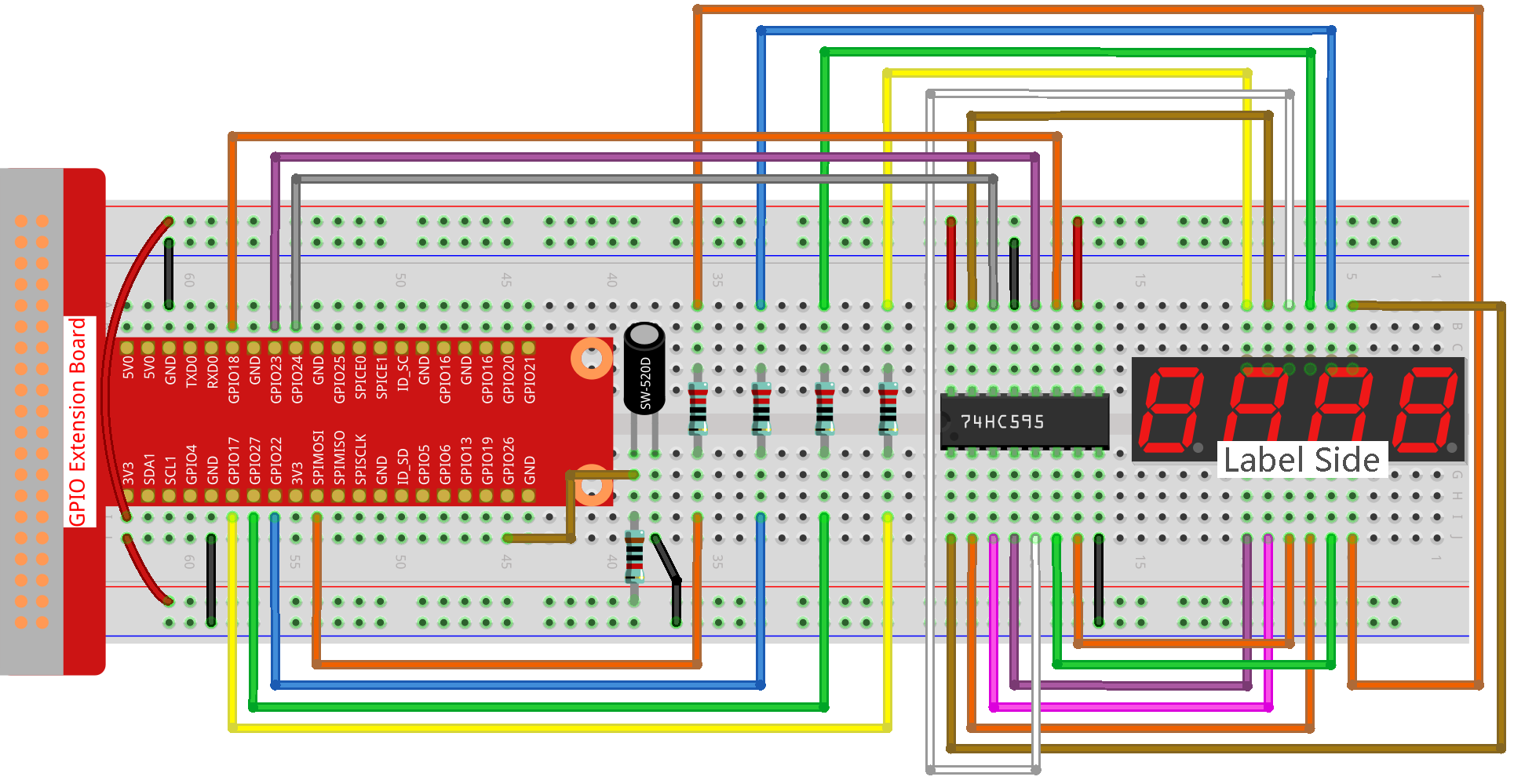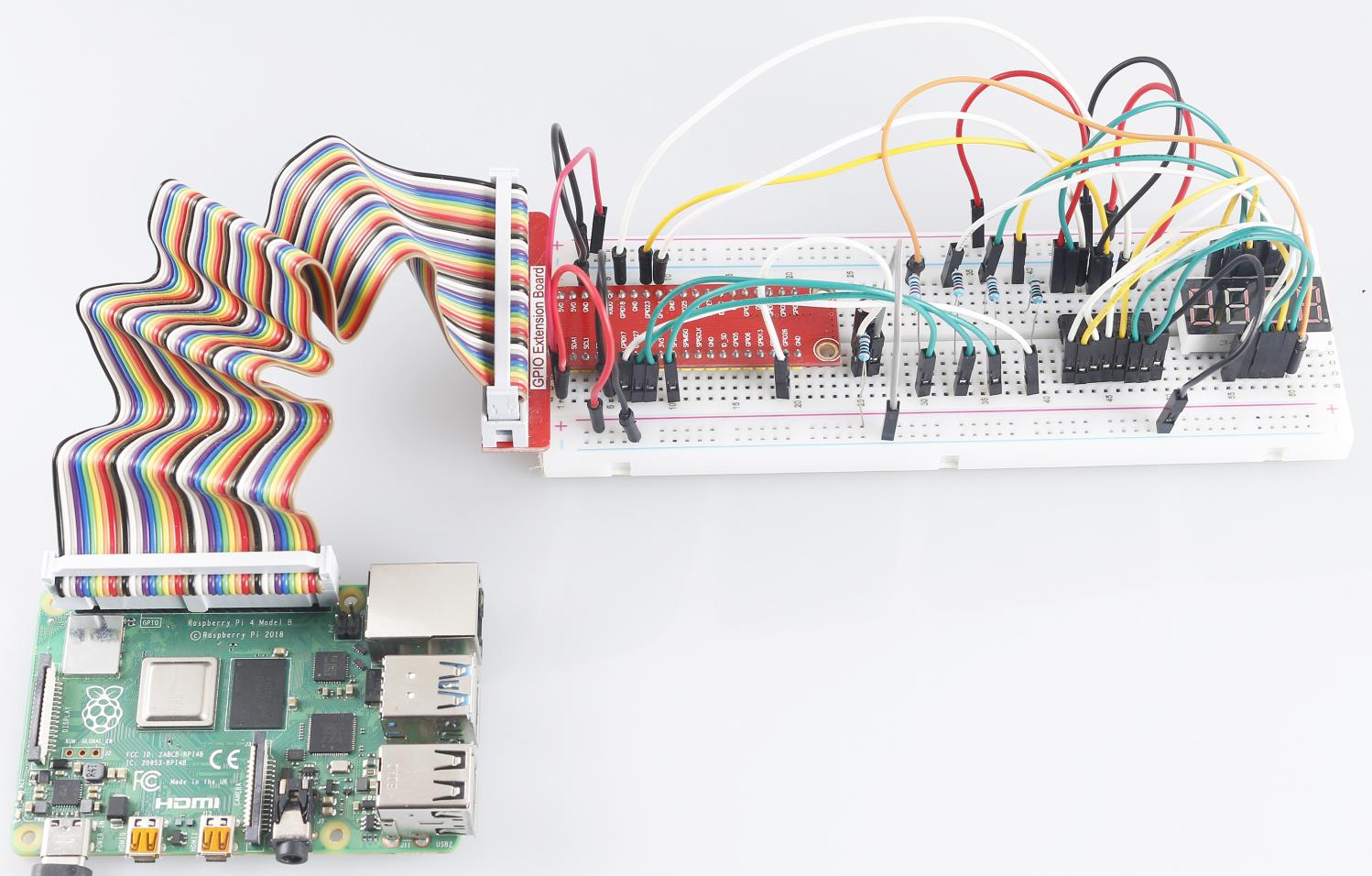Note
Hello, welcome to the SunFounder Raspberry Pi & Arduino & ESP32 Enthusiasts Community on Facebook! Dive deeper into Raspberry Pi, Arduino, and ESP32 with fellow enthusiasts.
Why Join?
Expert Support: Solve post-sale issues and technical challenges with help from our community and team.
Learn & Share: Exchange tips and tutorials to enhance your skills.
Exclusive Previews: Get early access to new product announcements and sneak peeks.
Special Discounts: Enjoy exclusive discounts on our newest products.
Festive Promotions and Giveaways: Take part in giveaways and holiday promotions.
👉 Ready to explore and create with us? Click [here] and join today!
4.1.18 GAME - 10 Second¶
Introduction¶
Next, follow me to make a game device to challenge your concentration. Tie the tilt switch to a stick to make a magic wand. Shake the wand, the 4-digit segment display will start counting, shake again will let it stop counting. If you succeed in keeping the displayed count at 10.00, then you win. You can play the game with your friends to see who is the time wizard.
Required Components¶
In this project, we need the following components.

It’s definitely convenient to buy a whole kit, here’s the link:
Name |
ITEMS IN THIS KIT |
LINK |
|---|---|---|
Raphael Kit |
337 |
You can also buy them separately from the links below.
COMPONENT INTRODUCTION |
PURCHASE LINK |
|---|---|
- |
|
- |
Schematic Diagram¶
T-Board Name |
physical |
wiringPi |
BCM |
GPIO17 |
Pin 11 |
0 |
17 |
GPIO27 |
Pin 13 |
2 |
27 |
GPIO22 |
Pin 15 |
3 |
22 |
SPIMOSI |
Pin 19 |
12 |
10 |
GPIO18 |
Pin 12 |
1 |
18 |
GPIO23 |
Pin 16 |
4 |
23 |
GPIO24 |
Pin 18 |
5 |
24 |
GPIO26 |
Pin 37 |
25 |
26 |

Experimental Procedures¶
Step 1: Build the circuit.

Step 2: Go to the folder of the code.
cd ~/raphael-kit/python/
Step 3: Run the executable file.
sudo python3 4.1.18_GAME_10Second.py
Shake the wand, the 4-digit segment display will start counting, shake again will let it stop counting. If you succeed in keeping the displayed count at 10.00, then you win. Shake it one more time to start the next round of the game.
Code
Note
You can Modify/Reset/Copy/Run/Stop the code below. But before that, you need to go to source code path like raphael-kit/python. After modifying the code, you can run it directly to see the effect.
#!/usr/bin/env python3
import RPi.GPIO as GPIO
import time
import threading
sensorPin = 26
SDI = 24
RCLK = 23
SRCLK = 18
placePin = (10, 22, 27, 17)
number = (0xc0, 0xf9, 0xa4, 0xb0, 0x99, 0x92, 0x82, 0xf8, 0x80, 0x90)
counter = 0
timer =0
gameState =0
def clearDisplay():
for i in range(8):
GPIO.output(SDI, 1)
GPIO.output(SRCLK, GPIO.HIGH)
GPIO.output(SRCLK, GPIO.LOW)
GPIO.output(RCLK, GPIO.HIGH)
GPIO.output(RCLK, GPIO.LOW)
def hc595_shift(data):
for i in range(8):
GPIO.output(SDI, 0x80 & (data << i))
GPIO.output(SRCLK, GPIO.HIGH)
GPIO.output(SRCLK, GPIO.LOW)
GPIO.output(RCLK, GPIO.HIGH)
GPIO.output(RCLK, GPIO.LOW)
def pickDigit(digit):
for i in placePin:
GPIO.output(i,GPIO.LOW)
GPIO.output(placePin[digit], GPIO.HIGH)
def display():
global counter
clearDisplay()
pickDigit(0)
hc595_shift(number[counter % 10])
clearDisplay()
pickDigit(1)
hc595_shift(number[counter % 100//10])
clearDisplay()
pickDigit(2)
hc595_shift(number[counter % 1000//100]-0x80)
clearDisplay()
pickDigit(3)
hc595_shift(number[counter % 10000//1000])
def stateChange():
global gameState
global counter
global timer1
if gameState == 0:
counter = 0
time.sleep(1)
timer()
elif gameState ==1:
timer1.cancel()
time.sleep(1)
gameState = (gameState+1)%2
def loop():
global counter
currentState = 0
lastState = 0
while True:
display()
currentState=GPIO.input(sensorPin)
if (currentState == 0) and (lastState == 1):
stateChange()
lastState=currentState
def timer():
global counter
global timer1
timer1 = threading.Timer(0.01, timer)
timer1.start()
counter += 1
def setup():
GPIO.setmode(GPIO.BCM)
GPIO.setup(SDI, GPIO.OUT)
GPIO.setup(RCLK, GPIO.OUT)
GPIO.setup(SRCLK, GPIO.OUT)
for i in placePin:
GPIO.setup(i, GPIO.OUT)
GPIO.setup(sensorPin, GPIO.IN)
def destroy(): # When "Ctrl+C" is pressed, the function is executed.
GPIO.cleanup()
global timer1
timer1.cancel()
if __name__ == '__main__': # Program starting from here
setup()
try:
loop()
except KeyboardInterrupt:
destroy()
Code Explanation
def stateChange():
global gameState
global counter
global timer1
if gameState == 0:
counter = 0
time.sleep(1)
timer()
elif gameState ==1:
timer1.cancel()
time.sleep(1)
gameState = (gameState+1)%2
The game is divided into two modes:
gameState==0 is the “start” mode, in which the time is timed and
displayed on the segment display, and the tilting switch is shaken to
enter the “show” mode.
gameState==1 is the “show” mode, which stops the timing and displays the
time on the segment display. Shaking the tilt switch again will reset
the timer and restart the game.
def loop():
global counter
currentState = 0
lastState = 0
while True:
display()
currentState=GPIO.input(sensorPin)
if (currentState == 0) and (lastState == 1):
stateChange()
lastState=currentState
loop() is the main function. First, the time is displayed on the 4-bit
segment display and the value of the tilt switch is read. If the state
of the tilt switch has changed, stateChange() is called.
def timer():
global counter
global timer1
timer1 = threading.Timer(0.01, timer)
timer1.start()
counter += 1
After the interval reaches 0.01s, the timer function is called; add 1 to counter, and the timer is used again to execute itself repeatedly every 0.01s.
Phenomenon Picture¶
